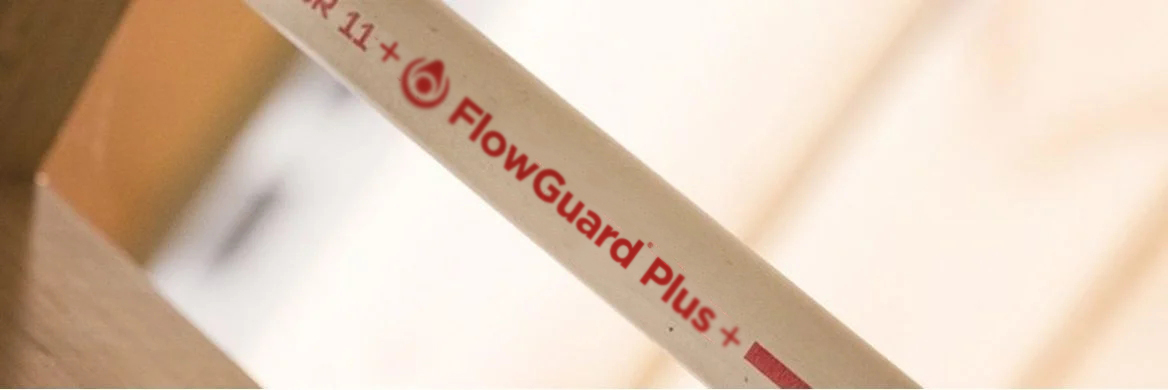
The Durability of CPVC in Harsh Conditions
Choosing or upgrading materials for a piping system, tank lining, ducting, and other large applications is a significant investment. It doesn't matter whether the upgrade is for commercial or industrial use. These costs can quickly add up if the material used cannot withstand harsh conditions.
The FlowGuard® Plus CPVC compound is manufactured with high standards of quality control and testing to ensure consistent results under the most demanding conditions, particularly in outdoor installations. FlowGuard CPVC plumbing systems have proven to be resistant to ultraviolet light, pressure and temperature extremes, and impacts. In this blog, we will learn about CPVC durability in various harsh conditions and what makes FlowGuard® Plus the world’s No 1 plumbing system.
The Different Conditions Where CPVC Thrives
Let us explore the different conditions in which CPVC thrives.
- Burst pressures: The water pipes in a domestic plumbing system are constantly held under pressure. Excessive pressure can wreak havoc in plumbing systems by resulting in a burst pipe as well as causing degradation or corrosion-related pressure limits. The plumbing codes necessitate that all domestic water plumbing systems be pressure-rated at 100 psi at 180°F, which implies that the system must be able to handle at least 100 psi of pressure at 180°F without ballooning or bursting. The best thing? FlowGuard Plus CPVC is pressure-rated to 400 psi at room temperature and 200 psi at all normal operating temperatures (up to 140°F).
- Extreme Temperatures: Weather changes can have a significant impact on the durability of a material. Whether it is the high temperatures from the hot sun or the freezing risks when it gets cold, using the wrong material for an application can lead to disastrous failures.
FlowGuard CPVC has a low thermal conductivity and has been meticulously formulated to be fire-resistant. When exposed to flame, CPVC will char, but it won't catch fire, sustain a flame, or drip molten material like other types of plastic. CPVC is equally durable at the cold end of the temperature range. It has no absolute minimum temperature for installation in outdoor environments; however, one must know the engineering requirements for a successful installation.
- Ultraviolet Light: CPVC Pipes are suitable for outdoor installations due to their resilience against UV light when compared to other plastic materials. This means that when exposed to UV light, it will not weaken the CPVC.
- Impact Testing: Not all plumbing pipe materials are tough enough to withstand the harsh impact of an outdoor or even underground installation, whereas CPVC compounds have the physical properties that help them resist impact without failing.
Testing of CPVC Material in Tough Weather Conditions
Let us take you through some CPVC testing methods to determine the material's ability to withstand tough conditions.
- Impact Test: To do this, place the pipe in a freezer that has a temperature of 0°C for an hour. Then, use a weight of 500g to strike the frozen pipe. You will notice that FlowGuard CPVC pipes will not break, whereas other plastic pipes will.
- Burst Pressure Test: To perform the CPVC pipe pressure testing, fill the welded CPVC pipe and CPVC fitting system with water and seal the pipe from one end. Place this system in a cold-water bath and cover it with a lid. Following this, start increasing the pressure. Here, you will discover that FlowGuard CPVC pipes can withstand pressure up to 123.4 kg/cm³. Other CPVC pipes, on the other hand, burst at 66.7 kg/cm³.
- Sustained Pressure Test: To do so, fill the CPVC pipe with water, seal the pipe from one end, and place it in a hot water bath with a temperature of 82°C. Now, increase the pressure to 25.59 kg/cm³ for about 4 hours. In the result, you will notice that the FlowGuard Plus CPVC pipe stays intact while the others deform and burst.
Frequently Asked Questions on CPVC Durability
- Does CPVC degrade in sunlight?
No. CPVC, especially that from FlowGuard Plus , is formulated with specialised UV-blocking agents. They are made with carbon black and titanium dioxide in amounts that are sufficient to withstand normal temperatures occurring before installation. The combination of titanium dioxide and carbon black protects the integrity of the CPVC. This further ensures CPVC durability, keeping the pipe’s pressure rating and other physical properties intact. - At what temperature does CPVC soften?
The ability of a CPVC material to withstand higher temperatures such as that ranging from 94°C to 110°C makes it an ideal choice for both hot and cold water applications. - Does CPVC get brittle with age?
Yes. As CPVC ages, it tends to become more rigid, increasing its pressure-bearing capability; however, this increased rigidity comes at the expense of reduced ductility, also known as "brittleness." - Can CPVC withstand high pressure?
Yes. CPVC can withstand high pressure, making it suitable for multiple residential and commercial applications. All domestic water plumbing systems must have a pressure rating of 100 psi at 180°F, which means they must be designed to handle at least 100 psi of pressure at 180°F without ballooning or bursting. CPVC pipes, particularly FlowGuard Plus CPVC, can handle much more. With a pressure rating of 400 psi at room temperature and at least 200 psi up to 140°F, you can be confident that your plumbing pipes can withstand the pressures faced in your projects.

Prasenjit Misra
Prasenjit Misra, an accomplished professional, having extensive exposure in plumbing field, currently holds the position of Lead Demand Creation & Business Development of TempRite South Asia division at Lubrizol India.
